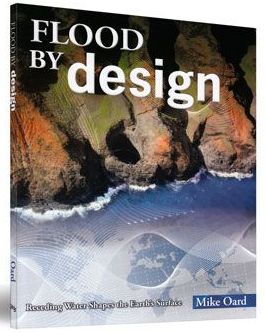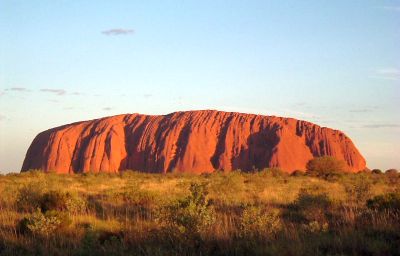Journal of Creation 23(1):33–35, April 2009
Browse our latest digital issue Subscribe
Visual evidence for Noah’s Flood
A review of Flood by Design: Receding Water Shapes the Earth’s Surface by Mike Oard
Master Books, Green Forest, AR, 2008

Mike Oard’s latest book covers one of the lesser travelled pathways in the creation-evolution debate; that of geomorphology, the study of landscapes. Given that landscapes, by means of the humble camera, are most assuredly one of the most visually recorded, appreciated and discussed entities on the planet it is rather surprising that the profile of geomorphology is not higher in these debates. This book does much to rectify this situation and place this study in its rightful context, providing compelling evidence for the reality of the biblical Flood that is observable to people everywhere as they go about their daily lives.
The book drives home the power of the arguments from landforms by continually raising a fundamental question:
“Why do geomorphologists experience such difficulty [in] explaining so many landforms?” (p. 20).
Given that landscapes are the most easily seen and investigated of natural phenomena it may surprise many readers that after some 200 years of intense study there is still little agreement amongst scientists on many aspects of geomorphology. Mike writes:
“Something as simple as scenery should have been easy to explain by present processes, if the theory [uniformitarianism] was adequate [to the task]” (p. 16).
Oard’s basic argument presented in the book is that the key assumption of uniformitarianism as continually applied by geomorphologists to their area of study is ineffective as a means of explaining the observations. He writes:
“Geomorphologists generally assume that present rates of weathering, river erosion, transport and deposition can account for all earth’s surface features. All they need is enough time” (p. 20).
But Oard shows how none of these processes are effective as explanations because the majority of landforms observed are actually being destroyed by present processes, not formed. Quoting from Green1 he states:
“… almost all landforms are relics and have not been shaped only, or even largely, by present-day processes. In other words, a powerful variable in the present-day geomorphological system is the relief inherited from the past and often shaped in environmental conditions very different from those of the present” (p. 20).
Add to this the recognition that water is one of the critical elements in the development of landscapes then the natural conclusion is that the Flood as described in Genesis, in particular its Recessive stage during which the floodwaters flowed from the continents into the newly forming oceans, is the causal factor for the scenery observed throughout the earth today. This is the central theme of Oard’s book.
In simple language with concise usage of references, Mike shows in his opening chapter that orthodox science is bereft of constructive explanations for mountains, plateaus, mesas, planation surfaces, huge canyons and gullies. To begin, he provides a concise description of geomorphology, stating that it is:
“… concerned with the geography, topography, shape and other permanent features of the earth’s surface” (p. 19).
In the early 1800s, geologists were especially concerned with the ‘origin of scenery’ and the spectacular landforms. The most famous hypothesis developed to explain the origin of landforms was that proposed by William Davis with his concept of cycles of erosion. As an undergraduate, I was exposed to this hypothesis in both geography and geology as it was then deemed foundational to the origin of landscapes. But as Mike so ably explains, this hypothesis is now considered erroneous and has been all but abandoned.
The notion of slow and gradual development of valleys, river systems, glacial systems and various scenic entities as a consequence of gradual development is simply not in keeping with the evidence presented before our eyes. Given that there is a wealth of material on the study of geomorphology it is rather surprising that experts in the field express considerable doubt as to having any explanations for the development of the landscapes they describe. Mike draws reasoned conclusions in each chapter as he takes the reader through a number of well-known landforms, showing how uniformitarianism fails to explain the evidence. He then describes how their formation can be elegantly explained with reference to the last 150 days of the Genesis Flood. This period is referred to as the ‘Retreating’ or Recessive stage of the Flood.
The book is very readable with a nice easy flow to the text and a wealth of photographic material that adds to the landscape wonders that Mike is expounding. Some of the vertical (aerial) photographs are indistinct and this does not readily aid in the development of the argument presented in the text: examples are figures 3.2 (p. 41) and 4.3 (p. 52). This is in marked contrast to the many photographs of the various landforms discussed in the text. These are clear, of high quality, and readily show the landforms and scenery being described. There are also many very clear schematics and diagrams which add considerably to the discussion in the text.
At the outset, although Mike does not seek to emphasise this point, one cannot help but be overwhelmed by the sheer scale and size of the features he discusses. Beautiful examples are shown in the photographs of the planation surface in Lander, Wyoming (p. 17) and Steamboat Rock, Washington State (p. 60). Even more mind boggling is to visualise canyons on the earth that are far greater in size than the Grand Canyon (p. 90). Other examples that are mind-numbing include seeing plains that are multiple hundreds of square kilometres in extent, such as a planation surface that once covered an area of 2,540 square kilometres before it was dissected by channel erosion in the late stages of the Flood (p. 68).

As Mike readily points out, planation features are a complete mystery for orthodox uniformitarian geology and geomorphology. Quoting from Ollier2 he explains how, although planation surfaces are common at all altitudes, they are not forming today. “It is very difficult to know how plains were originally created, but they can undoubtedly be seen in the landscape” (p. 70).
Again, Ollier and Pain3 marvel at how planation could even have occurred and yet the plains have remained flat despite uplift. Mike quotes a quite remarkable passage from their text, The Origin of Mountains, in which they make it clear that such planation surfaces could not have been formed by current processes:
“The remarkable thing is that plains of great perfection are ever made, despite all of the obvious possibilities of complications. But they are real, and planation surfaces were widespread before the uplift of the many mountains of Plio-Pleistocene age [very late Cenozoic]” (p. 70).
Mike concludes that there is no generally accepted mechanism for planation discernible in the literature. He quotes from Small:4
“Any serious student of geomorphology will quickly realise what is actually known with certainty about land forms and their origin is surprisingly small, despite the vast amount of research” (pp. 71–72).
Flood by Design covers a range of such geomorphic phenomena and ably shows how the features developed are easily understood within a context of receding Flood waters. This only serves to highlight, not only that orthodox views are bereft of conclusive ideas as to how landscapes came to be, but also the explanatory and predictive power of a biblical Flood model.
In contrast to the inadequate processes based on slow-and-gradual uniformitarian assumptions, Mike shows with reference to Mt St Helens and the Lake Missoula flood that catastrophic processes do excavate major features, including huge vertically walled valleys and canyons, within hours and days. For example, the Mt St Helens canyon was carved in a single day and yet it is 43 metres deep and overall one fortieth the size of the Grand Canyon (p.80).
One of the highlights of this book, although it is not spelt out in detail, is a little gem concerning the history of geomorphology. Mike writes:
“Contrary to the thoughts of modern geologists and many others, the Genesis Flood was never proven wrong in the 1800s. Scholars simply decided to believe that the rocks and fossils were laid down by slow processes over millions of years. There was little real knowledge of the rocks and fossils at this time” (p. 111).
It is perhaps ironic that after 200 years of research and data collection there is still little unanimity in the development and acceptance of the theoretical understanding of the development of the earth’s scenery—its geomorphology. Even though many geologists would argue, incorrectly, that the retreating stage of the biblical Flood is a religious rather than a scientific view, the landscape is a living testimony to this event. This is the legacy of the book.
Flood by Design is eminently readable, very well illustrated and should provide the interested person with a wealth of material to ponder and to develop in their own research. It will change the way you look at the world. I thoroughly recommend this book to all who would seek to better understand the scenery and natural features around us. It is a welcome addition to the creationist literature. The arguments are clear and concise and the examples are spectacularly depicted in photo and diagram. As the book cover states:
“Flood by Design takes you into a fascinating aspect of the Genesis flood you may never have considered.”
As I read this book I could not help but be reminded of the Scripture in Romans:
“For since the creation of the world God’s invisible qualities—His eternal power and divine nature—have been clearly seen, being understood from what has been made, so that men are without excuse” (Romans 1:20).
References
- Green, C.P., The shape of the future; in: Jones, D.K.C. (Ed.), The Shaping of Southern England, Institute of British Geographers Special Publication No. 11, Academic Press, New York, NY, pp. 249–260, 1980. Return to text.
- Ollier, C., Ancient Landforms, New York, Bellhaven Press, 1991. Return to text.
- Ollier, C. and Pain, C., The Origin of Mountains, Routledge, London, 2000. Return to text.
- Small, R.J., The Study of Landforms: A Textbook of Geomorphology, 2nd ed., Cambridge University Press, London, 1978. Return to text.




Readers’ comments
Comments are automatically closed 14 days after publication.